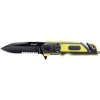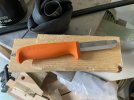I have been through a lot of different knives to use in a pinch for rescue purposes at work. None of them are replacements for the professional tools we carry, but can be used quickly if I don't have something else handy.
The Gerber Hinderer Rescue was one of the earliest and was decent, but compromised a lot for use as a regular knife. The unsharpened tip and bulkiness weren't my favorite and the use of steel for the glass breaker as opposed to carbide kinda limited the number of times you could use it. Tempered glass doesn't need a lot of force, just a small tip to generate high pressure. The steel point can round out over time and greatly increase the force needed to break tempered glass. I believe it has been discontinued but they still make the derivative
Combat Life Saver model in tactical black instead of red, and a sharpened point on the blade.
The Kershaw Funxion EMT also got pocket time at work for a while and is closer to the CLS model I listed than the Hinderer Rescue. A couple of the nice improvements were a flipper deployment for easier one handed opening, and a carabiner clip. Though honestly I no longer prefer spring assist models. The carabiner clip on it was also nice that I could clip it to my fire gear, and not have to dig inside to my pants pocket to get it, and the clip also served as a safety to prevent blade deployment. The carabiner spring eventually wore out, and I upgraded my gear, but I still have this in one of my vehicles just in case I am out and about with an empty pocket. The glass breaker is carbide and held up to better use. The cutting hook on this knife was used several times to open victims clothing for treatment, especially shirts to get defibrillator pads on, and I find a safe cutting hook or sheepsfoot in an emergency as a very important feature if I have to cut close to someone.
The best all around, if somewhat heavy knife I found for rescue purposes was the
Benchmade Outlast which is no longer in production either. It was a manual "Option Lock" (Axis lock) specially designed to offer two independently useful blades. A standard drop point in S30V for general use, and a fully serrated flat tipped blade in 3V for cutting rope/rough materials and emergency prying tasks. It also had a carbide breaker and 440C hook. That hook also got a lot of use. The
Tactical Triage is probably closest to it, but only has one combo edge blade leading to some compromises in usefulness, though it is lighter, thinner and cheaper.
Honestly though, I think the most practical setup is a
Raptor Rescue folding shear set paired with a knife you already trust. It has heavy duty shears plus a cutting hook offering two options for cutting around a victim, ring cutter or other soft metal cutter on the back side of the hinge, oxygen wrench, carbide glass breaker. They come with a pocket clip and can be carried opposite your main knife, or in a cargo pocket if you carry something else (light etc.) on your opposite side. I happily pair this with anything from an Ontario Rat in D2 to a Spyderco Gayle Bradley 2, and feel ready for any reasonable scenario.
I tend to keep at least one rescue designed knife in a locking cubby near my driving position in any vehicle I am in, but don't always carry one on me unless I am venturing far away from my vehicle. If I am specifically looking to be prepared either the Outlast or the Raptor paired with another trusty knife and at least one flashlight are with me. I'll usually have a heavy duty Leatherman (Surge or Super Tool) somewhere handy also.
MD is restrictive on fixed blades, so I tend not to carry them unless I have a specific need envisioned. I do carry a
Benchmade H20 dive knife with/near my fire gear. It is marketed as a dive knife but has a flat tip for prying, a combo edge blade on one side and cutting hook on the other. It comes in handy cutting away side impact airbags and being less likely to injure a victim in a car accident. It is N680 so pretty tough, virtually rust proof but only moderate edge holding. But as seldom as it sees use, that has not been issue so far.
I know this was originally on knives, but I would definitely add a commercial tourniquet (or 2) to your vehicle and a trusty flashlight. Get familiar with the use of the tourniquet and how to quickly apply it ahead of time.
For background, I started as a volunteer firefighter in 1997, and have been working full time career fire in a large metro area department since 2001 in a number of different assignments and ranks. I was an EMT early on, paramedic for the last 17 years or so, and also worked part time as a paramedic in an EMS only department for a bit where assistance from volunteer fire services could be delayed, so I have put my various knives/tools to work quite a bit over the years, but I won't say my experience will reflect everyone else's. A lot of firefighter just carry whatever $25-50 dollar knife they can pick up quickly and make it work. A lot of the cheaper "rescue" knives are not worth the name printed on the though.


